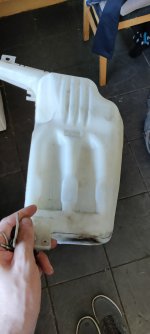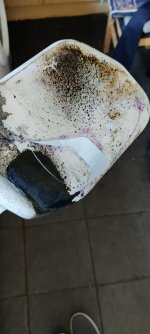Unlikely it's 5 cracks in the bottom of it and not much chance of glueing it with what's it's made of
Yeah i see , pretty much what i figured . Plastic is difficult to glue at the best of time , that's why i learnt to plastic weld . That little skill , has saved me over two grand to date . I would never suggest this with any kind of consumption storage tank , as i don't know what harmful effects could result , however as it's a windscreen reservoir , it is possible to repair using another method i learnt last year . It is however a long and drawn out preparation process , and a serious issue could be access . You must have full access to all the damage at least on one side .
As it's an engine component , you must first thoroughly degrease the bottle , both inside and out , with a proprietary degreasing agent . I would not advise the use of gunk , which tends to foam (personally i use a product called marine clean) , it needs to be strong but none foaming , ideally bio degradable . Scrub the area on the outside , if need be with a fine pan scrubber . Use the green type , this will scratch , but don't worry . Try and get into the crack as much as you can , and flush the inside several times , allow the bottle to dry .
The next stage is a little tricky , as ideally a Dremel , or similar , would be a serious advantage . You need to open the crack out slightly , i use an engraving bit in my Dremel , but it can be done with a sharp craft knife . Just for christ sake , watch you fingers . Scrape the blade sideways along the crack , getting the point into the crack . Don't worry about finish , and most importantly , don't go all the way through . The object is to open the crack out slightly , and produce a key for the glue to grip at the same time , along with a larger glue area . Now wash thoroughly again , but use washing up liquid this time . Again allow to dry thoroughly , for at least 24 hours , more if possible .
Now using a super glue (there are many brands to choose from) fill the crack , and follow immediately with either baking soda , or bicarbonate of soda . Make sure you get this powder into the crack , and it soaks into the glue , apply more glue is necessary .
I'll be honest here , it will look a mess .
Once dry , the surface will be left hard and uneven , which is difficult , though not impossible to sand , but you will need a Dremel . So take your time , and try to produce a tidy join . It really is a case of what you see , is what you've got , however don't forget the speed a super glue takes to cure . Leave for at least 12 hours , however i would recommend at least 48 , perhaps even several days if possible before getting it wet .
It is not a difficult process , but is time consuming . I have used this method to repair all manner of things , from freezer baskets , to a clutch bracket on my van , though i will admit , i reinforced the latter . At present i'm repairing thin plastic trim from the van . It's far too thin to use a conventional plastic welding process .



